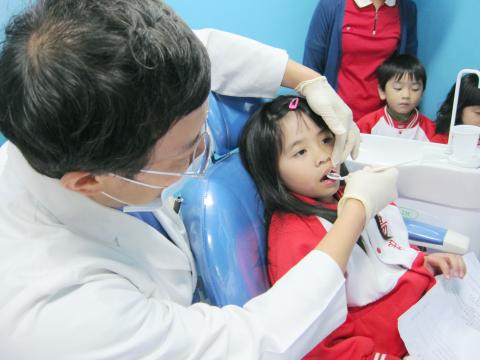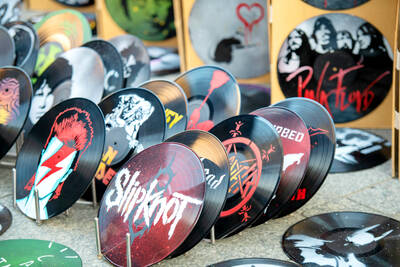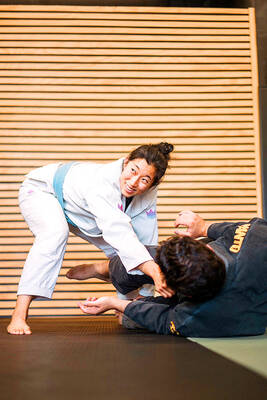Research shows that if parents have tooth decay the chances are higher that their young ones will also have cavities. The dental plaque DNA of parents and children are nearly identical. Apart from physique and hereditary factors, if parents chew food before feeding it to their child, use the same eating utensils or kiss their child on the lips, it can also increase the risk of exposing a child to saliva that contains dental plaque streptococci. For the sake of your child’s dental health, parents are reminded to be wary about their own dental hygiene.
Taiwan Academy of Pediatric Dentistry president Tsai Yi-feng says that nearly 80 percent of Taiwanese children six years of age or younger have dental caries, which is significantly higher than Europe or America — 40 percent — and neighboring Asian countries — 57 percent. Tsai says that it is worth bearing in mind that more than 80 percent of Taiwanese adults also have tooth decay, which shows that tooth decay rates for children and adults are intimately related.
According to a study from Finland, a child’s chances of having tooth decay are greater if both parents also have cavities, and inversely lower if they do not. The main reason for this is that mutant dental plaque from parents’ dental caries contaminates their offspring’s teeth, damaging the child’s teeth and eventually causing cavities.

photo: Pan Hsing-hui, Liberty Times
照片:自由時報記者潘杏惠
Tsai says that in order to take care of a child’s teeth, parents can start with two points of approach — be sure to take care of all tooth decay issues during pregnancy, and after the child is born make sure the child gets in the habit of cleaning their teeth. It is best to brush after all three meals, before going to bed, and also use dental floss. After a baby’s teeth come in, you should be sure to clean the child’s teeth before going to bed, Tsai says, adding if a child’s teeth come in close together you should definitely use dental floss.
It is worth mentioning that different age groups should brush their teeth differently. Taiwan Dental Association chairman Huang Mao-shuan says that children between the ages of zero and six can brush back and forth horizontally and use dental floss as a supplement, while children between six and nine years of age should brush one tooth at a time, gradually learning how to use the Bass brushing technique. Parents can also help children by assisting them brush permanent teeth such as molars and incisors. From the age of nine into adulthood, Huang says that people should pay attention to dental hygeine.
(Liberty Times, Translated by Kyle Jeffcoat)
研究發現,父母如果蛀牙,幼兒的蛀牙率也會較高,且幼兒和父母嘴裡的牙菌斑DNA幾乎相同,除了體質、遺傳因素外,父母嚼食物餵小孩、與孩子使用共同餐具及親嘴等行為,也提高了唾液中蛀牙鏈球菌的暴露風險,提醒父母為了幼兒的牙齒健康,平時應注意做好自身的潔牙工作。
中華民國兒童牙醫學會秘書長蔡宜峰表示,台灣六歲以下的兒童蛀牙率逼近百分之八十,遠高於歐美國家的百分之四十及亞洲鄰近國家的五十七,值得注意的是,國內成年人的齲齒率亦高達八成,兒童與成人蛀牙的比率呈現正相關。
根據芬蘭一項研究發現,如果父母蛀牙,其幼兒的蛀牙率也會跟著升高,反之則隨之降低,主要因為父母蛀牙中的變形鏈球菌會傳染給幼兒,進而破壞幼兒的牙齒,形成蛀牙。
蔡宜峰建議,照顧幼兒的牙齒,父母可從兩階段著手,懷孕期間一定要先把自己的蛀牙問題處理好;孩子出生後,父母一定要養成潔牙的習慣,三餐飯後及睡前最好能刷牙,並使用牙線;幼兒長牙後,每天睡前一定要為孩子清潔牙齒,如果孩子的牙齒長得密,一定要用牙線清潔。
值得一提的是,不同年齡也應配合不同的刷牙方式,中華民國牙醫師公會全國聯合會口衛主委黃茂栓表示,零至六歲的兒童可以水平來回刷牙以及牙線輔助;六至九歲開始換牙,應逐漸學習貝氏刷牙法,家長可加強協助刷恆牙大臼齒與門齒的部分;至於九歲以上至成人則要注意潔牙。
(自由時報記者魏怡嘉、洪素卿)

When people listen to music today, they typically use streaming services like YouTube or Spotify. However, traditional formats like vinyl records have regained popularity in recent times. Vinyl records are circular discs that store music in grooves on their surfaces and are played on a turntable. As the turntable’s needle runs along these grooves, it picks up vibrations and translates them into sound. The history of vinyl records dates back to the late 1800s, but material and technological challenges delayed mass production until the 1950s. Despite early versions having short playtimes and poor sound quality, vinyl records introduced a new era

A: Brazilian jiu-jitsu, known as “BJJ,” has become more and more popular. Even Hollywood stars like Halle Berry and Tom Hardy are obsessed with it. B: Some Asian stars, such as Taiwanese actor Eddie Peng and South Korean actor Lee Joon-gi, have also practiced this martial art. A: BJJ is not just a martial art, but also a combat sport. B: I’ve always wanted to try it, but I’m worried about getting injured. A: Diana Wang, a US doctor of physical therapy, is holding a BJJ seminar at PMA Brazilian Jiu-jitsu in Taipei Friday night. Let’s go check out how we

Picture a 45-foot-long animal with a 5-foot-long skull and 3-foot-long arms. It may not seem strange until you realize that a human with those proportions would be 6 feet tall with 5-inch arms. Although the Tyrannosaurus rex went extinct 65 million years ago, the mystery of its unusual body __1__ has fascinated scientists for over a century. Barnum Brown, the paleontologist who first discovered T. rex fossils, initially found it hard to believe that the tiny arms belonged to such a __2__ creature. One of his colleagues speculated that the short forelimbs might have been used to hold the

A: Actually, Brazilian jiu-jitsu is particularly good for small people like you. B: Really? How so? A: According to Diana Wang, a US doctor of physical therapy, the BJJ’s purpose is to help smaller, weaker people defend themselves by using various techniques, such as leverage. B: That sounds interesting. What time does Dr Wang’s BJJ seminar begin tonight? A: The event is scheduled for 7:30pm at PMA Brazilian Jiu-jitsu in Taipei. Admission is free, but donations are welcome. A: 其實你的個子比較小,很適合練巴西柔術呢。 B: 真的嗎?為什麼? A: 據美國理療醫師王幼瑞博士說,巴西柔術的概念是讓弱小的人,也能利用槓桿作用等技巧防身。 B: 真有趣,王醫師的巴柔研討會幾點開始? A: 今晚7點半在「台北巴柔運動館」,免費入場自由樂捐唷! (By Eddy Chang, Taipei Times/台北時報張迪)